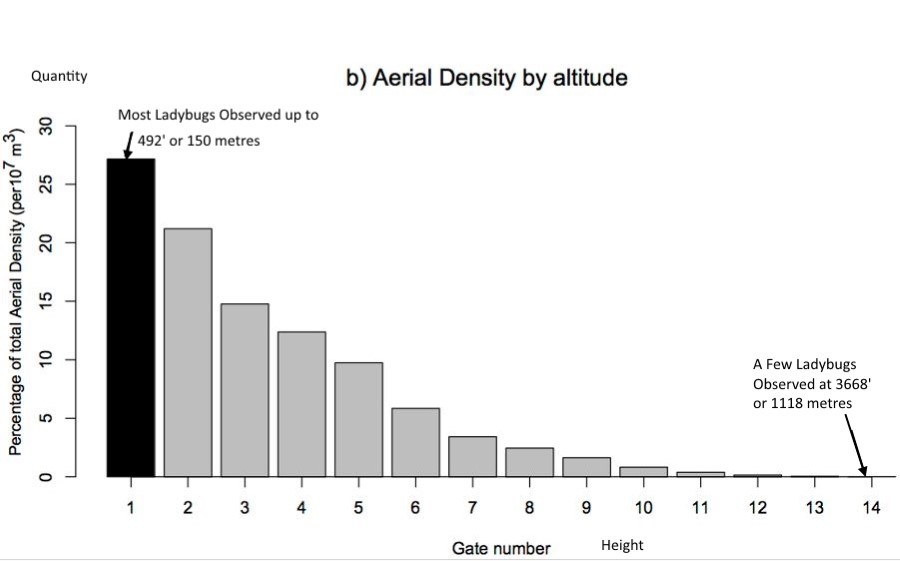Can ladybugs fly? Is one question. Sure they can, and the way in which ladybugs fold their wings is really an amazing feat of nature. I can’t think of many other creatures that fold their wings in quite the same way and then draw them in underneath a protective hood.
But to look at them you might not instantly know they have wings at all and can actually fly. So I can understand this question to a degree. Allow me to answer it for you and delve a little deeper into Ladybugs and flight – some of these things are quite surprising.
Can ladybugs fly? and how ladybugs fly:
Yes, Ladybugs can fly. They can reach speeds of up to 37mph, and go as high as 3,600 feet. In fact, their flight ability is seriously underrated. It may not seem obvious at first as they intricately fold their wings under their protective wing cases (elytra).
Here’s even more amazing information.
We don’t really think of Ladybugs as particularly fast or adept flyers, but when it comes to flight, Ladybugs are far more surprising than you think.
I’ve taken some of these statistics from a research study undertaken by Dr Lori Lawson Handley of Hull University, and her team who were studying the invasion of the Harlequin/Asian Lady Beetle across the United Kingdom. This is the best research available in providing hard data on the flight of Ladybugs.
For their studies, the team used specialist equipment to create a cone of beam light into the air that could detect Ladybugs by size and weight.
From this, they could detect the height, speed, and distance of the flight, and produce data to add to their research. I’ve highlighted some of their findings in the headings below.
Here’s what they said regarding the study:-
We analysed 10 years of radar data collected … to investigate characteristics (altitude, speed, seasonal and annual trends) and drivers (aphid abundance, air temperature, wind speed and rainfall) of high-altitude flight of the two most abundant U.K. ladybird species.
10 Years of radar data sound pretty comprehensive to me! … so let’s start with…
How Do Ladybugs Fly?
To help explain this, here’s a diagram of the anatomy highlighting the main components of the ladybug flying anatomy:

Just before they intend to take off, Ladybugs flex the muscles anchored at the base of the Elytra, which raises the protective casing over their wings. This reveals gossamer wings which will already be unfolding as the Elytra rise.
The wings then begin to flap and can reach speeds of up to 85 times per second. The flapping pattern continues non-stop and is similar to that of birds and other insects such as bees.
As the front of the wing leads the rear is being raised, then leads the rear of the wing back down again in a flowing fashion to bring air in and under.
As the wings raise and lower the elytra remain in a raised forward position, acting as fore-wings as well as increasing stability. This means Ladybugs are pretty aerodynamic and better flyers than you might think.
As the Ladybug lands, the process is simply reversed, the wings are folded back under the protective elytra and they are lowered back into place.
Here’s a YouTube video of a Ladybug in slow motion, spreading her wings and taking flight…
How Far Can Ladybugs Fly?
For the most part, Ladybugs will fly for no more than a few minutes. The length and deviation of flight depend on what type of terrain they’re traversing, and the scents they detect whilst in the air, whether that of aphids, other prey, other gatherings of Ladybirds, or even potential mates.
Ladybugs have been recorded as reaching speeds of up to 37 mph which is as fast as a racehorse. Until the study was carried out, it was believed the length of the flight of a Ladybug was around 7 feet – on average.
In terms of altitude, Ladybugs have been recorded as high up as 3,600 feet. As high as a small mountain. Dr. Lori Lawson Handley of Hull University states that the Ladybugs are able to maintain a high speed due to their high protein diet, mainly consisting of aphids.
Below I’ve added a graph from the research and highlighted the main findings. Specifically, the height/altitude at which the most …and the fewest Ladybugs were observed…

How Long Can Ladybugs Fly?
Ladybugs typically remain in the air for a few minutes in most garden settings, however, in the study, they were recorded as flying for up to 2 hours without stopping – which is amazing considering their size.
This means that in theory, if a Ladybug were in the air for 2 hours, and could travel at a speed of 37 mph, it could actually fly a distance of 74 miles.
In reality, though this was not found to be the norm in the study, and would (I suspect) probably represent a major extreme, it’s unlikely many ladybugs would be in the air that long, and of those, not many would be flying full tilt at 37mph for a full 2 hours.
Having said that, at a greater height you could probably expect their flight time to be greater, as altitude pressure is lower, although there is an additional distance to cover to reach that height.
It’s probably more realistic to say the range of a few miles is probably the most a Ladybug would look to achieve before selecting somewhere to settle.

Can Ladybugs Fly in the Rain?
Actually, no, as with a lot of insects, it’s extremely difficult for Ladybugs to fly in the rain. For the most part too, it would not make sense to expend the extra energy needed when they can simply choose to rest, or crawl. If you do see one, it’s likely that it has been disturbed and/or forced to move.
In actual fact, during anything more than mild rainfall, Ladybugs seek shelter rather than try to fly. At most, they may search for any food locally where they are undercover.

Ever seen a Purple Ladybug?
Learn more about Purple Ladybugs
Can Ladybugs Fly at Night?
Ladybugs probably could fly at night, (except during Winter) but they choose not to. Similar to flying in the rain, it would not make sense to fly at night as their vision is not suited to night flying and they also need to rest. Instead, they would seek shelter for the night and resume activities in the morning.
Can Baby Ladybugs Fly
No, during this early stage of the Ladybug Life Cycle, Ladybug Larvae are unable to fly. When laying eggs, the female would attempt to lay them near to a ready supply of food such as an aphid colony. As well as lay additional dummy eggs that the Larvae can consume to gain energy quickly.
Can Male Ladybugs Fly?
Yes, there is no obvious distinction between male Ladybugs or Female Ladybugs. Aside from their genitalia, they have the same physical appearance and the same physical attributes. Both are able to fly, crawl and swim. They also both have the same protection mechanisms.
Can Ladybugs Fly – Conclusion
Once again I hope our little Ladybug friends have surprised you with what they can actually do. The most surprising to me – aside from the speed and height of their flight, is that scientists assumed most ladybug flights were around seven feet in length. Well, they certainly surprised researchers!
I hope this has been useful in understanding the flight of Ladybugs, as well as how high can a ladybug fly – and at what speed a ladybug can fly.
If you know someone who is as crazy (well almost) as crazed about ladybugs as I am then head over to my resources and gifts section where you’ll find lots of cute, stylish, and thoughtful gifts, projects, and activities.
Did You Know…
An estimated three billion insects fly through a 1 km2 ‘window’ of
the sky in England during a typical summer month
Related Questions
Can Ladybugs Fly to Death? A Ladybug is unlikely to fly intentionally to the point of death. Before that point, they will most likely become exhausted and need to rest and/or look for food and water. However, regardless of whether a Ladybug is crawling along the ground or in flight, if it’s their time to go, then it’s time to go. So, whether in flight, walking, or eating. If their bodies finally give out, then that will be the point at which they pass. If this is in mid-flight, then so be it
Here’s how to tell if a ladybug is dead, dying, or hibernating.


